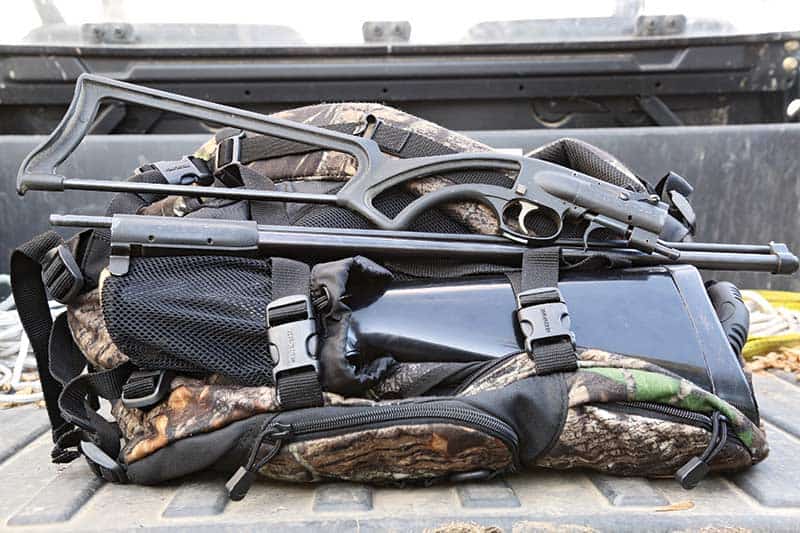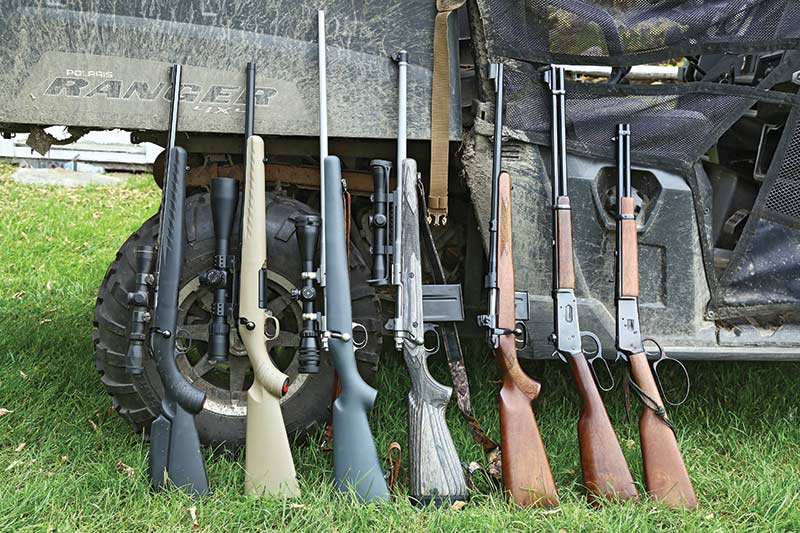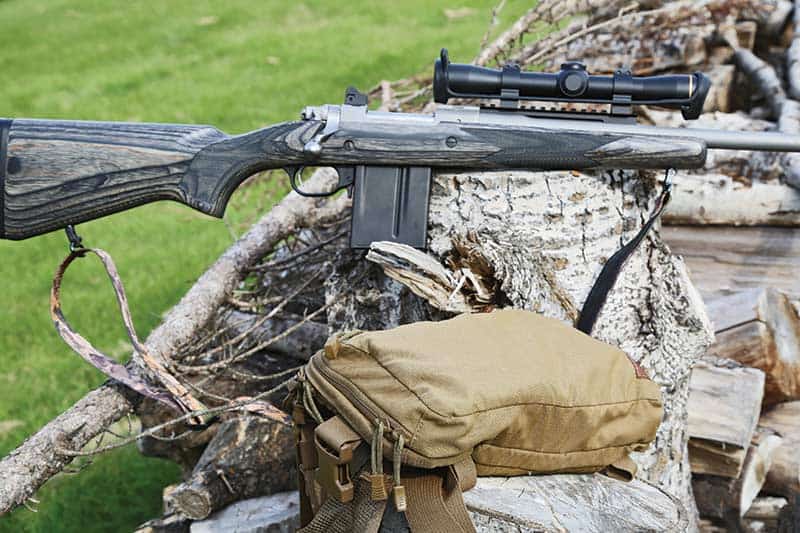Survival Preparing For...
The term “survival guns” means different things to different people. Long ago a survival gun meant one you could use to live off the land in the wilderness. It was a firearm stored in a backpack, boat, canoe, bush plane, dog sled, or off-road vehicle along with other survival gear appropriate for the environment.
The main issue with such survival guns is ammunition. There’s a tradeoff between cartridge power, and the number of cartridges available (especially if you’re backpacking). The .22 LR is a popular choice. Ammunition is light, it is effective on small game and birds, and can take deer-size game with precise shot placement.

Dave still thinks of “survival guns” as those intended for use in unexpected
wilderness emergencies. The AR-7 takedown .22 stores the components
in the stock. His was made when Charter Arms owned the manufacturing
rights. Currently the rifle is available from Henry Rifles. The all-metal Garcia
Bronco .410 shotgun is inexpensive and not currently made.
Making precise head shots on deer isn’t quite as easy as it sounds. Personally I’d like a bit more power. At one time the USAF issued the M4, a compact bolt-action rifle, chambered for .22 Hornet. It was a pretty good choice, and still is.
I like the .22 WMR. While I’ve never shot a deer with it (or with the .22 LR for that matter), I have shot coyotes with both and in my experience the WMR round is substantially more effective. Ammunition is fairly light, with options of both expanding and solid bullets in weights from 30 to 50 grains. And yes, I’m (painfully) aware WMR ammo is currently hard to find and expensive.
My favorite WMR rifle is the discontinued Winchester 9422M, which can be taken down for compact storage. Currently there are several decent WMR rifles from Henry, Marlin, Savage and others. For handiness and ease of storage I’d go with the Ruger American Compact.
Another class of survival guns involves “Urban Survival” for city dwellers in the event of some kind of natural or manmade disaster. This is something with which I have no expertise. Currently I divide my time between a small city (about 37,000), and a remote farm with the nearest traffic light about 50 miles away.
I’ve never lived in a big city. I have spent a few days in cities like New York and Los Angeles. I don’t feel qualified to provide advice on survival guns or any other aspect of urban survival. Heck, I have enough trouble surviving in big cities when times are good.
Another aspect involves long-term survival in the event of total societal collapse. Many people have a romantic attraction for the idea of a self-sufficient, back-to-the-land lifestyle. I find the concept appealing myself, the reality rather less so. Growing up on the farm, just about everything we ate came from the garden or from livestock we raised—cattle, hogs, chickens, turkeys, ducks, geese, and trout planted in one of several large ponds.
From what I read on the Internet, it seems the long-term plan for many people is to stockpile 5 or 10 years supply of food and toilet paper along with many guns and tens of thousands of rounds of ammunition. They seem to envisage a lifestyle consisting of gun battles with looters, who obligingly stand around to be shot.
Survivalists
I knew a young couple who survived under harsher conditions than most today can envisage. By dint of hard work and saving, when they arrived at their 160-acre land claim they had a horse, wagon, cow, a few tools (including a .22 rifle) and clothes.
It was October 1905. They were both 22 years old. There was nothing on the land but prairie and trees. They were “off the grid” since the grid didn’t exist, and wouldn’t for some decades. A harsh Saskatchewan winter was fast approaching. The wife was six months pregnant.
There was an immigrant family on about every 160-acre parcel, from many different countries and speaking different languages. Every household had a gun. Most of the men had military training and experience, mandatory at the time in the European countries from which they had emigrated.
So how did those pioneers survive and prosper? Well, they didn’t do it by shooting each other. Neighbors helped one another to build shelters, sod shacks at first, then modest frame houses. They got together and built a church, and then a school.

If a centerfire is desired, Dave seldom steps out the door of his farm without taking along one of these rifles. In order of his preference (left to right) are the Ruger American Ranch Rifle .223 Rem (Weaver 4-20x50 scope), Kimber Montana .223 Rem (Redfield Battlezone 3-9x42), Ruger Scout .308 (Leupold Scout scope), CZ-527 carbine in 7.62x39 (NECG peep sight), Winchester 94 .30-30 Win (Lyman receiver sight), and the Rossi 92 .357 Magnum.
They learned a common language, though the English was spoken with a dozen different accents. They celebrated together at weddings and mourned together at funerals. They traded skills they had for skills others had.
The young man was a trained carpenter. When neighbors got together to build a house or a barn he knew what materials were needed, how to build a foundation square and straight. Everyone contributed one way or another. Those who didn’t know how to make rafters at least knew how to drive a nail—and if not, they carried lumber and nails for those who did.
The young couple kept their growing family fed almost exclusively with produce they raised, fish caught in a nearby lake, and small game and birds taken with the little .22 rifle. They made bread from flour ground from wheat they had grown.
Twenty years later they had acquired considerably more land, built a large barn and a big modern house, and were making a good living from grain and livestock. Not to mention the wife had given birth to nine children and buried two of them.
Applied Skills
My point is simply this; in the long run you will survive as part of a society, or you won’t survive. What will make you a valued member of society is skill at producing something others need. Back then they needed doctors, nurses, farmers, police, blacksmiths, veterinarians, carpenters, storekeepers, plumbers, and anyone who would provide an honest day’s labor for a day’s pay.
They didn’t need social workers, community organizers, grief counselors, professional athletes, entertainers or helpless ninnies. They didn’t need outdoor writers either, (though then, as now, outdoor writers worked cheap.)
The couple in my story was my paternal grandparents. We still live in the house they built in 1925. I really don’t want to go back to their lifestyle. The work was arduous and dangerous, infant mortality heartbreaking, people died from what today would be minor injuries or illnesses. But we could if we had to.
We still raise, shoot, or catch a substantial part of our diet. So what rifles are needed? Well, you have to protect your food supply against looters. These looters go by such names as gophers, squirrels, raccoons, coyotes, foxes, crows, skunks, magpies, and weasels. The one absolute essential is an accurate .22 LR. We wouldn’t have had much of a garden this year if I hadn’t shot multitudes of gophers and a couple of raccoons. And the .22 can supplement the diet with small game.
The second essential is a rifle capable of taking whatever bigger game is available, which usually means deer. It’s useful if it is a fairly flat-shooting cartridge to do double duty for longer range varmint shooting. I think a .223 does nicely but I won’t argue if you want something bigger.
Ammunition resupply is always a concern. I think it is smart to have something capable of shooting the most popular cartridges available in your area. For me that means .22 LR, .223 Rem, .308 Win, 7.62×39, .30-30 Win and .357 Mag.




